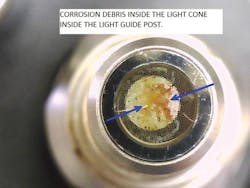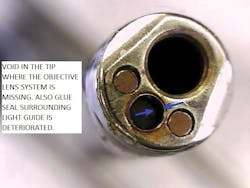What are some of the most obviouswarning signs your endoscopic equipment has not been cleanedproperly before high-level disinfection or sterilization?Sterile processing experts from providers and suppliershighlight missing links from the fundamental to the advanced.
Someof the most obvious warning signs include visible clinical soilon surface or in the endoscope, discoloration or difference inequipment appearance or texture, which can indicate remainingdebris/clinical soil on the device, and flush water that isn’tclear. If the device does not pass a cleaning verification testthis can be another obvious sign as the tests are an establishedbenchmark for acceptable cleaning threshold. Also, failure ofphysical parameters for automated endoscope reprocessor (AER) orfailure of minimum effective concentration (MEC) test are bothvery obvious indications that the equipment is not functioningor the disinfectant concentration is inadequate.
Janet Prust, 3M Health CJanet Prust, Director, Global Scientific Marketing and Education, 3M Health Care
The most obvious sign that yourequipment has not been cleaned properly is visible dirt ordamage on the scope. However, there are other warning signswithin processes that could call out potential risks including,reuse of disposable cleaning brushes, enzymatic detergent ordisinfectant; cutting corners to meet tight deadlines, such asskipping pre-cleaning steps in the procedure room or notspending the required amount of time manually cleaning thescope; inadequate education, training or routine competencyassessments.
Grace Thornhill, Ph.D., Infection Prevention Fellow, Boston Scientific Corp.
- Visible smudging or specks on thescope; unclean outer surface of scope
- Debris discharged from the channelwhen tested and flushed prior to use
- Scope still on cart with a closedturnover bag
- Scope stored is not disassembled
Alicia Titzmann, Senior Clinical Operations Consultant, Cardinal Health
- Visible debris indicates incorrectand/or incomplete manual cleaning
- Visible damage to the endoscopeindicates repair is needed before use. Microorganismslocated within damaged areas can evade contact withreprocessing tools (i.e., brushes) and detergents/chemicals
- Valves or other removable partswere not removed during manual cleaning, which would impedeeffective cleaning in the areas immediately adjacent
- Improper use of cleaning brushes.Single-use brushes must be discarded after each use, andreusable brushes must be cleaned and disinfected orsterilized between uses. Reusable brushes must be discardedupon observing signs of wear
- Endoscope manufacturer’sInstructions for Use (IFU) are not followed. IFUs outline avalidated cleaning protocol for each endoscope that must beperformed as-written after every endoscopy procedure.
- Error reports from your automatedendoscope reprocessor (AER), indicating an incomplete cycle
Melinda Benedict, CFER, Manager, Infection Control Program, Olympus America Inc.
In order to recognize some of the mostapparent indications that your endoscopic equipment has not beenadequately cleaned, a careful and thorough inspection must beperformed. Particularly in the case of flexible scopes, such aninspection can be useful in identifying small problems beforethey become critical, causing damage and high repair costs, orcompromising safety. Regardless of the type of equipment, athorough inspection can identify such issues as debris andresidue in the distal window of an endoscope, jaws that arefrozen shut on a forceps, bone fragments and other debris in thejaws of a ronguer, and others.
Other indications of improper cleaning caninclude debris that is visible in the bottom of thesterilization container, fluid seen draining from the workingchannel of a flexible endoscope or the inability to pass aninstrument through the working channel, or a wet sponge thatcomes away soiled when used to wipe an instrument. Any of thoseissues may be a vital warning sign requiring attention — both tothe item and to the process that allowed the problem to develop.
We generally consider one of the principle toolsfor the care and handling of flexible scopes to be the leaktester that is supplied with all new scopes. According to KarlStorz instructions for use (IFU), leak testing is advised atthree points: Prior to decontamination, after reprocessing andbefore use. Doing so can facilitate identification of a scopewith a leak that can be repaired while it is still relativelyminor.
In its “Top 10 Health Technology Hazards for2017,” ECRI Institute listed the cleaning of complex reusablemedical devices, including flexible endoscopes and others, asthe second-ranked hazard. They recognized that the use of suchmedical devices, once contaminated, can result in dangerousinfections as well as device malfunctions that can pose risks.The report suggested that staff should always follow themanufacturer cleaning instructions for the device, and shouldpre-clean devices at the point of use.
The report also emphasized the criticalimportance of using the correct cleaning agent and propertechniques. Use of incompatible cleaning solutions, based on thematerials used in the devices construction or its design, canpose risks as well. During site visits and other interactionswith staff, we emphasize the importance of taking a systemicapproach to processing management and promoting a team effort.This includes providing in-service training for OR and otherstaff regarding the care and handling of endoscopic equipment,as well as the importance of pre-cleaning.
Crit Fisher, Director, Field Ops, Protection1, KARL STORZ Endoscopy-America Inc.
- Residual bio-burden present on thedistal end of the endoscope
- Odor present in/on the endoscopeafter cleaning
- Bio-burden leaking from theendoscope
- Cleaning verification tests withpositive results indicating the cleaning processes wereunsuccessful
- Scope accessories such as buttonsnot being removed during cleaning processes
Brianne Flesher, CFER, Product Manager, Mobile Instrument Service & Repair, Flexible Endoscope Repair Division
- Improperly placed scopeconnections
- Missing “clean” tags
- Sterilization report showsinadequate time or temperature; failed sterilization test
- Improper storage
- Endoscope still wet
Angela Maxwell, Senior Clinical Operations Consultant, Cardinal Health
Visible blood, mucous, or stool —visible debris may be found by the SPD tech upon completion ofprocessing cycle, or the end user when preparing to use thedevice.
Jean Sargent, President, Sargent Healthcare Strategies
- Film on scope
- Bits of debris (bioburden andmicrobial burden) visible to the eye
- Lens appears opaque or cloudy orboth.
- Lens may demonstrate “speck-like”debris
- Channels are not patent
- Working components do not moveeasily or are stiff
Melanie Miller, Healthcare Value Management Experts Inc.
- Visual residue on device
- Detergent solution cloudy
- Cleaning solution not at propertemperature
- Cloudy lens
- Shaft is dented
- High-level disinfection solutionnot at correct minimum concentration
Donna Swenson, President and CEO, SterileProcessing Quality Services Inc.
- The A/W channel and/or nozzle isclogged.
- There is a restriction in thebiopsy/suction channel (potentially dried debris or a kink).
- There are visible cracks orpeeling in the insertion tube or light guide tube.
- Presence of visible debris on thedistal end, insertion tube, control body, light guide tubeor electrical connector.
- The scope fails a protein,carbohydrate or hemoglobin test.
Chris Antonucci, Director of Marketing, STERIS Infection Prevention Technologies
Some signs that an endoscope has notbeen properly cleaned is the clear visible sign of bioburdenthat has been left on a scope while doing a visual inspection.
Some additional signs include:
- No available documentation thatthe scope was cleaned.
- No visual reference that a scopeis clean, such as a tag or container that displays a “clean”symbol.
- No documentation that averification process for manual cleaning, such as an ATPtest, was performed or a positive test that indicates anunclean or poorly cleaned scope.
Robert B. Dybec, RN, CPSN, CNOR, OperatingRoom Nurse Manager at Winthrop-University Hospital, Mineola, NY,and a clinical consultant, Ruhof Corp.
- Odor present when handling scopeprior to sterilization
- Residual bioburden
- Scopes not being rinsed properlyleaving residue due to improper water purification.
- Distal end lens is hazy
- Light guide bundle has reducedoutput
- C-Cover intact, but has impactdamage
- Clogged air-water nozzle
- Glue degradation from manysterilizations
- Staffing producing an ineffectivecleaning activity influenced by low salary, substandardtraining
- Leak testing must be performed forthe recommended amount of time. There are many slow leaksthat are difficult to detect (based on the angulation orsize of the leak). In fact, some leaks are introduced afterthe post-leak detection phase.
Jon Whinnery, CHL, CSPDT, CRCST, CIS, CNA, Operations Manager, Paces MedEquip LLC
Read on…
About the Author
Rick Dana Barlow
Senior Editor
Rick Dana Barlow is Senior Editor for Healthcare Purchasing News, an Endeavor Business Media publication. He can be reached at [email protected].




